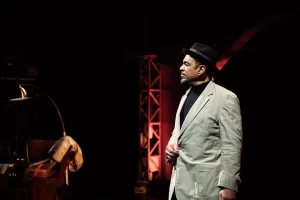
 ***** Harry Lennix channels August Wilson to a “T” in the show “How I Learned What I Learned”, a solo performance based on the world-class playwright’s autobiography, written three years before he passed away from liver cancer in 2005. Featuring an engaging script and great storytelling, the memoir starts out with Wilson’s poetry and morphs into a personal account about his obscure beginnings as a black man living in The Hill District, a rough neighborhood just steps from downtown Pittsburgh. The presentation largely consists of a series of episodes in chronological order having to do with how Wilson learned to achieve success in American society despite the odds, especially as they relate to racial segregation. Moreover, by revealing his shortcomings and insecurities, Wilson makes his life’s struggles relatable whether you come from an African American background or not. Narrations, observations, commentary, and humor are all rolled into one highly entertaining production, due in large part by brilliant direction by Ken-Matt Martin.
***** Harry Lennix channels August Wilson to a “T” in the show “How I Learned What I Learned”, a solo performance based on the world-class playwright’s autobiography, written three years before he passed away from liver cancer in 2005. Featuring an engaging script and great storytelling, the memoir starts out with Wilson’s poetry and morphs into a personal account about his obscure beginnings as a black man living in The Hill District, a rough neighborhood just steps from downtown Pittsburgh. The presentation largely consists of a series of episodes in chronological order having to do with how Wilson learned to achieve success in American society despite the odds, especially as they relate to racial segregation. Moreover, by revealing his shortcomings and insecurities, Wilson makes his life’s struggles relatable whether you come from an African American background or not. Narrations, observations, commentary, and humor are all rolled into one highly entertaining production, due in large part by brilliant direction by Ken-Matt Martin.
One of the first things we notice when Lennix takes the stage is that he wears a black t-shirt with white letters that reads “I’m supposed to be white.” Does this sentence refer to the actor or to the playwright or to Clarence Thomas or to some unknown person making a lot of money from selling this particular t-shirt? Lennix seems to break character for a moment. But it is when he reveals a comfortable plain shirt underneath this one that he turns back into Wilson. Then we hear his discussion about what being in church really means. If church is supposed to be a place of communion and following God’s teachings, then why were the congregants where he grew up so segregated by race? How could some white people justify throwing a brick into the window of a house owned by African Americans to violently oust them from the neighborhood? His thesis, which guides much of the play, is that the patently false and negative attitudes among whites regarding formerly enslaved people have been engrained into the larger culture and were perpetuated for far too many years after the Civil War ended. He pulls out Webster’s International Dictionary Third Edition (1961) and makes a cleverly constructed argument to emphasize his point. (Now you’ll have to purchase a ticket and see for yourself just how well he does this!)
In this memoir, we see how Wilson navigates the color line and overcomes racial bias and adversity to gain international fame. He explains how he quit a number of jobs rather than to give in to racism. He details moments when he might’ve been killed and relates that violence and threats of violence and carrying guns were part of the culture among black men that was “normal in that environment.” Most important was the lesson that his mother taught him when he was very young, that is, the value of respect and being treated as a full person, equal to everybody else. There are lots of great lines from the show, one of which is: “Something is not always better than nothing” (and if you’ll have to come to a performance to find out what this means). Then, of course, there’s the line: “How I learned what I learned has led me to places I’ve wanted to go.”
Practically all the vignettes contain some comedic moments and reflections that are meant to be humorous. Being able to create some laughs about so many very real situations is what makes the presentation so special, especially when some swear words and the “N” word are thrown into the mix. In addition, Lennix plays several of Wilson’s friends and associates. By changing his voice and mannerisms as well as his uses of the English language, the actor nicely depicts characters from different classes and walks of life and from diverse settings within the African American community.
Sydney Lynne Thomas’s set design is gorgeous: It’s a gem of a garret or finished attic in a presumed Georgian or Victorian house. I loved the room’s semicircular window, otherwise known as a fanlight, as well as the archway in front of it which exactly copies the curve. Prop designer Lonnae Hickman has done an incredible job displaying all the books in the room: Organized books line the archway as compared to lots of other books strewn about. The overstuffed chairs are perfect; the desk (which later mimics a piano) is great; and the design behind everything is so authentic that we feel we could just walk into the room and be at home. As the show proceeds, I liked how well Lennix continually and comfortably interacts with his surroundings as he picks up books, pulls out drawers, reads papers, and the like. Jason Lynch’s lighting design is spot on: It not only delineates episodes and remembrances but moods. Projection design by Rasean Davonté Johnson could not have been any better. The title of each episode is posted at the beginning of each scene on the proscenium arch, which is also covered with changing words and themes throughout the entire performance. The show ends with the projection of all of the titles of Wilson’s writings.
Throughout his life, Wilson has had to become a translator, meaning that he has gained a mastery of the uses of culture and language among different sets of people as well as the ability to navigate between different social classes and subcultures. More specifically, his writings serve as a bridge between African Americans and whites and between people of color and the mainstream society. Through the effective use of translations and explanations—not to mention his life example—he has done a brilliant thing. Not only do black people come to understand his situation but he brings it home to whites as well, so that they might see a perspective on the world that they may not have previously considered. So whatever your background, we can all learn what it meant to grow up as an African American man in Pittsburgh in the 1950s and 1960s.
This is one the best shows I’ve seen this season. When Lennix convincingly plays Wilson, there is never a break in the words or action as he constantly moves from one part of the stage to another—and, in so doing, he keeps the audience mesmerized. In portraying the playwright so beautifully, Lennix has allowed theatregoers to enter Wilson’s world and to have it become a part of ours for roughly 90 minutes with no intermission (and not the 1 hour and 45 minutes that you might have otherwise seen on the internet). My guest, who has followed the Chicago-born Lennix for years, was thrilled to finally see him in person. He does such an amazing job that you too will be delighted to watch him perform on stage! This is a limited engagement, so be sure to buy your tickets for this production while it’s still playing in Chicago.
“How I Learned What I Learned” is a production of Congo Square Theatre Company in association with Goodman Theatre. It runs through May 5, 2024, at Broadway In Chicago’s Broadway Playhouse, 175 E. Chestnut Street, at Water Tower Place, in Chicago.
Tickets, depending on date and seat location – $21.50-$91.50, plus applicable fees.
Performance schedule:
 Tuesdays, Wednesdays, Thursdays – 7:00 p.m.
Tuesdays, Wednesdays, Thursdays – 7:00 p.m.
Fridays – 7:30 p.m.
Saturdays – 2:00 p.m. and 7:30 p.m.
Sundays – 1:00 p.m.
Additional performances:
Sunday, April 28th at 6:30 p.m. and
Wednesday, May 1st at 1:00 p.m.
For more information and to purchase tickets, visit https://www.congosquaretheatre.org/how-i-learned-what-i-learned.
To see what others are saying, visit www.theatreinchicago.com, go to Review Round-Up and click at “How I Learned What I Learned”.






More Stories
“The Magic School Bus: Lost in the Solar System”
“February House” reviewed by Julia W. Rath
” A Lie of The Mind”